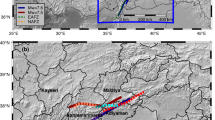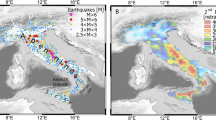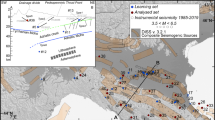Abstract
Obtaining high-quality measurements close to a large earthquake is not easy: one has to be in the right place at the right time with the right instruments. Such a convergence happened, for the first time, when the 28 September 2004 Parkfield, California, earthquake occurred on the San Andreas fault in the middle of a dense network of instruments designed to record it. The resulting data reveal aspects of the earthquake process never before seen. Here we show what these data, when combined with data from earlier Parkfield earthquakes, tell us about earthquake physics and earthquake prediction. The 2004 Parkfield earthquake, with its lack of obvious precursors, demonstrates that reliable short-term earthquake prediction still is not achievable. To reduce the societal impact of earthquakes now, we should focus on developing the next generation of models that can provide better predictions of the strength and location of damaging ground shaking.
This is a preview of subscription content, access via your institution
Access options
Subscribe to this journal
Receive 51 print issues and online access
$199.00 per year
only $3.90 per issue
Buy this article
- Purchase on Springer Link
- Instant access to full article PDF
Prices may be subject to local taxes which are calculated during checkout





Similar content being viewed by others
References
Sieh, K. E. Slip along the San Andreas Fault associated with the great 1857 earthquake. Bull. Seismol. Soc. Am. 68, 1421–1447 (1978)
Toppozada, T. R., Branum, D. M., Reichle, M. S. & Hallstrom, C. L. San Andreas fault zone, California; M ≥ 5.5 earthquake history. Bull. Seismol. Soc. Am. 92, 2555–2601 (2002)
Bakun, W. H. & McEvilly, T. V. Recurrence models and Parkfield, California, earthquakes. J. Geophys. Res. 89, 3051–3058 (1984)
Shearer, C. F. Southern San Andreas fault geometry and fault zone deformation: implications for earthquake prediction (National Earthquake Prediction Council Meeting, March, 1985). US Geol. Surv. Open-file Rep. 85–507, 173–174 (USGS, Reston, Virginia, 1985).
Bakun, W. H. & Lindh, A. G. The Parkfield, California, earthquake prediction experiment. Science 229, 619–624 (1985)
Sherburne, R. W. Ground shaking and engineering studies near the San Andreas fault zone. Calif. Geol. 41, 27–32 (1988)
Bakun, W. H. et al. Parkfield, California, earthquake prediction scenarios and response plans. US Geol. Surv. Open-file Rep. 87–192, 1–45 (USGS, Reston, Virginia, 1987).
Hill, D. P. et al. Response plans for volcanic hazards in the Long Valley caldera and Mono Craters area, California. US Geol. Surv. Open-file Rep. 91–270, 1–64 (USGS, Reston, Virginia, 1991).
USGS Advanced National Seismic Systemhttp://earthquake.usgs.gov/anss/ (USGS Earthquake Hazards Program, 2000).
Hickman, S., Zoback, M. & Ellsworth, W. Introduction to the special section: preparing for the San Andreas Fault Observatory at depth. Geophys. Res. Lett. 31, L12S01, doi:10.1029/2004GL020688 (2004)
Earthscope Project Exploring the Structure and Evolution of the North American Continenthttp://www.earthscope.org/ (2003).
National Earthquake Prediction Evaluation Council Working Group. Earthquake research at Parkfield, California, 1993 and beyond—report of the NEPEC working group to evaluate the Parkfield earthquake prediction experiment. US Geol. Surv. Circ. 1116, 1–14 (USGS, Reston, Virginia, 1994).
Langbein, J. et al. Preliminary report on the 28 September 2004, M6.0 Parkfield, California, earthquake. Seismol. Res. Lett. 76, 10–26 (2005)
Shakal, A. et al. Preliminary analysis of strong-motion recordings from the 28 September 2004 Parkfield, California earthquake. Seismol. Res. Lett. 76, 27–39 (2005)
Rikitake, T. Earthquake Prediction 7–26 (Elsevier, Amsterdam, Netherlands, 1976)
Bakun, W. H. & McEvilly, T. V. Earthquakes near Parkfield, California; comparing the 1934 and 1966 sequences. Science 205, 1375–1377 (1979)
Nadeau, R. M. & Dolenc, D. Nonvolvanic tremors deep beneath the San Andreas fault. Science 307, 389, doi:10.1126/science.1107142 (2004)
Harris, R. A. Numerical simulations of large earthquakes: Dynamic rupture propagation on heterogeneous faults. Pure Appl. Geophys. 161, 2171–2181, doi:10.1007/s00024–004–2556–8 (2004)
Lindh, A. G. & Boore, D. M. Control of rupture by fault geometry during the 1966 Parkfield earthquake. Bull. Seismol. Soc. Am. 71, 95–116 (1981)
Eberhart-Phillips, D. & Michael, A. J. Three-dimensional velocity structure, seismicity, and fault structure in the Parkfield region, Central California. J. Geophys. Res. 98, 15737–15758 (1993)
Liu, J., Klinger, Y., Sieh, K. & Rubin, C. Six similar sequential ruptures of the San Andreas Fault, Carrizo Plain, California. Geology 32, 649–652 (2004)
Irwin, W. P. & Barnes, I. Effect of geologic structure and metamorphic fluids on seismic behaviour of the San Andreas fault system in central and northern California. Geology 3, 713–716 (1975)
Working Group on California Earthquake Probabilities. Earthquake probabilities in the San Francisco Bay region: 2002–2031. US Geol. Surv. Open-file Rep. 03–214, 1–340 (USGS, Reston, Virginia, 2003).
Dragert, H., Wang, K. L. & James, T. S. A silent slip event on the deeper Cascadia subduction interface. Science 292, 1525–1528 (2001)
Kawasaki, I. et al. The 1992 Sanriku-Oki, Japan, ultra-slow earthquakes. J. Phys. Earth 43, 105–116 (1995)
Harris, R. A. & Segall, P. Detection of a locked zone at depth on the Parkfield, California segment of the San Andreas fault. J. Geophys. Res. 92, 7945–7962 (1987)
Lienkaemper, J. J. & Prescott, W. H. Historic surface slip along the San Andreas fault near Parkfield, California. J. Geophys. Res. 94, 17647–17670 (1989)
Lienkaemper, J. J., Baker, B. & McFarland, F. S. Slip in the 2004 Parkfield, California earthquake measured on alinement arrays. Eos 85 (47), Abstr. S54B–01 (2004)
CISN Strong Motion Engineering Data Centerhttp://www.quake.ca.gov/cisn-edc/ (2000).
California Geological Survey Alquist-Priolo Earthquake Fault Zoneshttp://www.consrv.ca.gov/CGS/rghm/ap/ (1998).
Schwartz, D. P. & Coppersmith, K. J. Fault behaviour and characteristic earthquakes; examples from the Wasatch and San Andreas fault zones. J. Geophys. Res. 89, 5681–5698 (1984)
Frankel, A. D. et al. USGS national seismic hazard maps. Earthq. Spect. 16, 1–19 (2000)
Michael, A. J. & Jones, L. M. Seismicity alert probabilities at Parkfield, California, revisited. Bull. Seismol. Soc. Am. 88, 117–130 (1998)
Murray, J. R. & Segall, P. Testing time-predictable earthquake recurrence by direct measure of strain accumulation and release. Nature 419, 287–291 (2002)
Segall, P. & Du, Y. How similar were the 1934 and 1966 Parkfield earthquakes? J. Geophys. Res. 98, 4527–4538 (1993)
Shimazaki, K. & Nakata, T. Time-predictable recurrence model for large earthquakes. Geophys. Res. Lett. 7, 279–282 (1980)
Ben-Zion, Y., Rice, J. R. & Dmowska, R. Interaction of the San Andreas fault creeping segment with adjacent great rupture zones, and earthquake recurrence at Parkfield. J. Geophys. Res. 98, 2135–2144 (1993)
Savage, J. C. The Parkfield Prediction Fallacy. Bull. Seismol. Soc. Am. 83, 1–6 (1993)
Nadeau, R. M. & McEvilly, T. V. Fault slip rates at depth from recurrence intervals of repeating earthquakes. Science 285, 718–721 (1999)
Beeler, N. M., Lockner, D. A. & Hickman, S. H. A simple creep-slip and stick-slip model for repeating earthquakes and its application to micro-earthquakes at Parkfield. Bull. Seismol. Soc. Am. 91, 1797–1804 (2001)
Kagan, Y. Y. & Jackson, D. D. New seismic gap hypothesis: Five years after. J. Geophys. Res. 100, 3943–3959 (1995)
Nishenko, S. P. Circum-Pacific seismic potential—1989–1999. Pure Appl. Geophys. 135, 169–259 (1991)
Main, I. Is reliable earthquake prediction of individual earthquakes a realistic scientific goal?http://www.nature.com/nature/debates/earthquake/equake_contents.html (Nature Debate 25 February to 8 April 1999).
Waldhauser, F. & Ellsworth, W. L. A double-difference earthquake location algorithm; method and application to the northern Hayward Fault, California. Bull. Seismol. Soc. Am. 90, 1353–1368 (2000)
Schaff, D. P., Beroza, G. C. & Shaw, B. E. Post-seismic response of repeating earthquakes. Geophys. Res. Lett. 107, B9, doi:10.1029/2001JB000633 (1998)
Uchida, N., Matsuzawa, T., Igarashi, T. & Hasegawa, A. Interplate quasi-static slip off Sanriku, NE Japan, estimated from repeating earthquakes. Geophys. Res. Lett. 30, doi:10.1029/2003GL017452 (2003)
Johnston, M. J. S. & Linde, A. T. Implications of crustal strain during conventional, slow, and silent earthquakes. Int. Handbk Earthq. Eng. Seismol. 81A, 589–605 (2002)
Michael, A. J. & Eberhart-Phillips, D. M. Relations among fault behaviour, subsurface geology, and three-dimensional velocity models. Science 253, 651–654 (1991)
Waldhauser, F., Ellsworth, W. L., Schaff, D. P. & Cole, A. Streaks, multiplets, and holes: high-resolution spatio-temporal behaviour of Parkfield seismicity. Geophys. Res. Lett. 31, L18608, doi:10.1029/2004GL020649 (2004)
Ji, C., Choi, K. K., King, N., Larson, K. M. & Hudnut, K. W. Co-seismic slip history and early afterslip of the Parkfield earthquake. Eos 85 (47), Abstr. S53D–04 (2004)
CISN ShakeMap. Estimated Instrumental Intensityhttp://www.quake.ca.gov/shake/index.html (1997).
Boore, D. M., Joyner, W. B. & Fumal, T. E. Equations for estimating horizontal response spectra and peak acceleration from Western North American earthquakes: A summary of recent work. Seismol. Res Lett. 68, 128–153 (1997)
Acknowledgements
The Parkfield experiment has served as a model for the collaboration of federal and state agencies with researchers in academia and industry, and many, far too numerous to list here, have contributed to its successes. In particular, J. Davis, J. Filson, A. Lindh and T. McEvilly made the experiment happen. We thank T. Hanks, S. Hough, D. Jackson, Y. Kagan, A. Lindh, M. Rymer, W. Thatcher, D. Wald and M. L. Zoback for their comments and suggestions and L. Blair, J. Boatwright, M. Huang, and D. Wald for technical assistance.
Author information
Authors and Affiliations
Corresponding author
Ethics declarations
Competing interests
Reprints and permissions information is available at npg.nature.com/reprintsandpermissions. The authors declare no competing financial interests.
Supplementary information
Supplementary Figure S1
Estimates of MW and epicenter location for historical Parkfield earthquakes from MMI assignments relative to the rupture of the 2004 event (thick purple line). (PDF 267 kb)
Supplementary Figure S2
Three possible sequences of earthquakes at Parkfield are tested for non-randomness with the Kolmogorov-Smirnov goodness-of-fit test. (PDF 219 kb)
Supplementary Figure S3
Peak horizontal acceleration from the CISN ShakeMap26 as a function of distance from the fault rupture. (PDF 63 kb)
Supplementary Figure S4
Spatial distribution of Parkfield aftershocks and background seismicity. (PDF 127 kb)
Supplementary Notes
This file contains the Supplementary Discussion, Supplementary Figure Legends and Supplementary Tables S1 and S2. (DOC 621 kb)
Rights and permissions
About this article
Cite this article
Bakun, W., Aagaard, B., Dost, B. et al. Implications for prediction and hazard assessment from the 2004 Parkfield earthquake. Nature 437, 969–974 (2005). https://doi.org/10.1038/nature04067
Received:
Accepted:
Issue Date:
DOI: https://doi.org/10.1038/nature04067
This article is cited by
-
Insights into seismicity from the perspective of the crustal stress field: a comment
Natural Hazards (2022)
-
Predicting the Timing of Catastrophic Failure During Triaxial Compression: Insights from Discrete Element Method Simulations
Pure and Applied Geophysics (2022)
-
Assessing the role of absolute stress measurement and relative stress real-time monitoring for earthquake research
Arabian Journal of Geosciences (2022)
-
Approaches to Solving the Maximum Possible Earthquake Magnitude (Mmax) Problem
Surveys in Geophysics (2022)
-
A review on deformation-induced electromagnetic radiation detection: history and current status of the technique
Journal of Materials Science (2021)
Comments
By submitting a comment you agree to abide by our Terms and Community Guidelines. If you find something abusive or that does not comply with our terms or guidelines please flag it as inappropriate.



